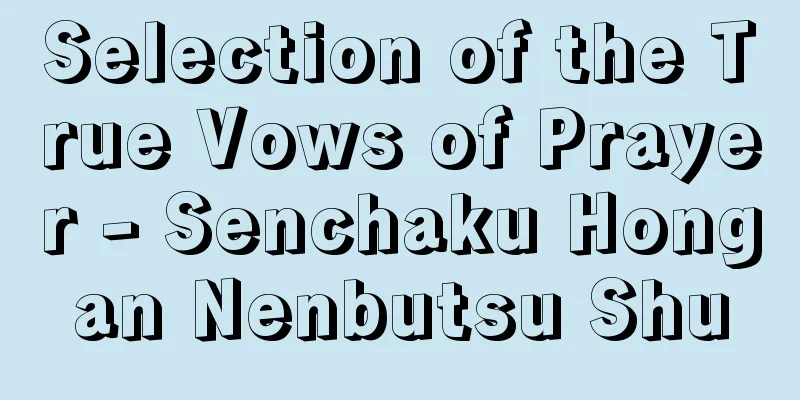Selection of the True Vows of Prayer - Senchaku Hongan Nenbutsu Shu

|
It is also read as "Senjaku~". It is a Buddhist book from the Kamakura period. It is one volume long and is abbreviated as "Senjakushu". It is the main work of Honen (Genku), who founded the Jodo sect. It is the fundamental scripture of the Jodo sect, composed in March 1198 (Kenkyu 9) at the age of 66, at the request of Kujo Kanezane, and consists of 16 chapters. Using Zendo's Pure Land doctrine as the sutra and his own selected doctrine as the syllabary, he collected the key passages of the Original Vow Nembutsu selected by Amida Buddha, and clarified the true meaning of the Selected Vow. He pointed out that all Buddhist training and daily activities can be traced back to the single practice of chanting Amida Buddha's name, clearly set out an example for encouraging those who aspire to be reborn in the Pure Land to have peace of mind, take action, and work, and stressed the reason why the teachings of rebirth in the Pure Land are appropriate for the time. The old scroll "Seikenshu" in the possession of Rozanji Temple in Kyoto is considered to be a rough draft. The first 21 characters of the book "Seiken Hongan Nembutsu Shu" and the next line "Namu Amida Butsu, the work of nembutsu for rebirth in the Pure Land is the first" were written by Honen himself, but the rest of the text was written by his disciples. When this book was published, it was subjected to fierce criticism and attack from Taoists who sought enlightenment in this world. Also, the number of commentaries and reprints of this book is extremely large. These facts show how much attention this book attracted from the public, both in terms of faith and slander. [Yasuhito Todo] "The Complete Lectures on Selections by Norimichi Ishii (1959, Supporters' Association for Publication of the Book)" A book published in the Edo period. Written by Genku, published in 1849 (Kaei 2). Owned by the National Diet Library . "Senkei Hongan Nembutsu Shu" Source: Shogakukan Encyclopedia Nipponica About Encyclopedia Nipponica Information | Legend |
|
「せんじゃく~」とも読む。鎌倉時代の仏書。一巻。略して『選択集』という。浄土宗を開創した法然(ほうねん)(源空)の主著で、1198年(建久9)3月、66歳のとき九条兼実(かねざね)の懇請に応じて撰述(せんじゅつ)された浄土宗の根本聖典で、16章からなっている。善導(ぜんどう)の浄土教義を経(けい)とし、自らの選択義を緯(い)として、阿弥陀仏(あみだぶつ)によって選択された本願念仏の要文を集め、選択本願の真意を明らかにした。 仏道修行や生活行動のすべてが称名念仏(しょうみょうねんぶつ)の一行に帰結することを指摘し、願生者(がんしょうしゃ)に安心(あんじん)・起行(きぎょう)・作業(さごう)を策励する軌範を明示し、往生(おうじょう)浄土の法門が時機相応の教えであるゆえんを力説した。京都廬山(ろざん)寺所蔵の古鈔(こしょう)本『選択集』は草稿本とみなされる。その開巻劈頭(へきとう)の「選択本願念仏集」と次行の「南無(なむ)阿弥陀仏往生之業念仏為先」の21字は法然の自筆であるが、それ以降はすべて門弟の執筆である。本書が世に出ると、この世で悟りを得ようとする聖道家(しょうどうけ)から猛烈な批判攻撃を受けたこと、また本書の注釈書と開版の数がすこぶる多いことは、信謗(しんぼう)両面にわたって本書がいかに世人の注目を集めたかを物語っている。 [藤堂恭俊] 『石井教道著『選択集全講』(1959・同書刊行後援会)』 江戸時代の刊本。源空著 1849年(嘉永2)刊国立国会図書館所蔵"> 『選択本願念仏集』 出典 小学館 日本大百科全書(ニッポニカ)日本大百科全書(ニッポニカ)について 情報 | 凡例 |
Recommend
Mizunomaki
An ancient imperial ranch thought to have occupied...
Iseji - Iseji
Originally, this road was a route taken by people...
Prefecture - Agatai
〘 noun 〙① Living in the countryside. Country livin...
Ostmark (English spelling)
After the decline of the Frankish Kingdom, the Eas...
Clownfish - anemonefish
A general term for marine fish of the family Poma...
Public Security Intelligence Agency
Based on the National Administrative Organization...
Machinery Credit Insurance Law
...In order to contribute to the modernization of...
The Brockhaus Encyclopedia - The Brockhaus Encyclopedia (English)
Germany's leading encyclopedia. Published by ...
Nasu clan
A medieval samurai family based in Nasu County, Sh...
Carajás Mountains - Carajás Family (English name) Serra dos Carajás
Located 550km southwest of the mouth of the Amazon...
Four Seas
〘noun〙① The seas on all four sides. Yomonoumi. ※Su...
Tegucigalpa (English spelling)
The capital of Honduras and the department of Fran...
Electrokinetic potential - Electrokinetic potential
…Since the system as a whole is electrically neut...
Mitake
A mountain in the western part of Ome City, Tokyo....
Kinguruma - Kinguruma
...As the snow melts in spring, the pair of leave...









